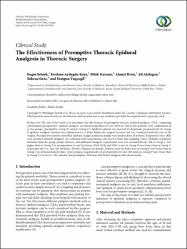| dc.contributor.author | Ertürk, Engin | |
| dc.contributor.author | Kaya, Ferdane Aydoğdu | |
| dc.contributor.author | Kutanış, Dilek | |
| dc.contributor.author | Beşir, Ahmet | |
| dc.contributor.author | Akdoğan, Ali | |
| dc.contributor.author | Geze, Şükran | |
| dc.contributor.author | Tuğcugil, Ersagun | |
| dc.date.accessioned | 2020-12-19T20:03:42Z | |
| dc.date.available | 2020-12-19T20:03:42Z | |
| dc.date.issued | 2014 | |
| dc.identifier.citation | Erturk, E., Kaya, F.A:, Kutanis, D., Besir, A., Akdogan, A., Geze, S., Tugcugil, E., (2014). The Effectiveness of Preemptive Thoracic Epidural Analgesia in Thoracic Surgery. Biomed Research International, 2014, article number 673682. https://doi.org/10.1155/2014/673682 | |
| dc.identifier.issn | 2314-6133 | |
| dc.identifier.issn | 2314-6141 | |
| dc.identifier.uri | https://doi.org/10.1155/2014/673682 | |
| dc.identifier.uri | https://hdl.handle.net/11436/3216 | |
| dc.description | akdogan, ali/0000-0001-7592-3844; Erturk, Engin/0000-0002-5864-1754 | en_US |
| dc.description | WOS: 000333347900001 | en_US |
| dc.description | PubMed: 24745020 | en_US |
| dc.description.abstract | Background. the aim of this study is to investigate the effectiveness of preemptive thoracic epidural analgesia (TEA) comparing conventional postoperative epidural analgesia on thoracotomy. Material and Methods. Forty-four patients were randomized in to two groups (preemptive: Group P, control: Group C). Epidural catheter was inserted in all patients preoperatively. in Group P, epidural analgesic solution was administered as a bolus before the surgical incision and was continued until the end of the surgery. Postoperative patient controlled epidural analgesia infusion pumps were prepared for all patients. Respiratory rates (RR) were recorded. Patient's analgesia was evaluated with visual analog scale at rest (VASr) and coughing (VASc). Number of patient's demands from the pump, pump's delivery, and additional analgesic requirement were also recorded. Results. RR in Group C was higher than in Group P at postoperative 1st and 2nd hours. Both VASr and VASc scores in Group P were lower than in Group C at postoperative 1st, 2nd, and 4th hours. Patient's demand and pump's delivery count for bolus dose in Group P were lower than in Group C in all measurement times. Total analgesic requirements on postoperative 1st and 24th hours in Group P were lower than in Group C. Conclusion. We consider that preemptive TEA may offer better analgesia after thoracotomy. | en_US |
| dc.language.iso | eng | en_US |
| dc.publisher | Hindawi Ltd | en_US |
| dc.rights | info:eu-repo/semantics/openAccess | en_US |
| dc.subject | Postoperative pain | en_US |
| dc.subject | Bupivacaine | en_US |
| dc.subject | Thoracotomy | en_US |
| dc.subject | Relief | en_US |
| dc.subject | Fentanyl | en_US |
| dc.title | The effectiveness of preemptive thoracic epidural analgesia in thoracic surgery | en_US |
| dc.type | article | en_US |
| dc.contributor.department | RTEÜ, Tıp Fakültesi, Cerrahi Tıp Bilimleri Bölümü | en_US |
| dc.contributor.institutionauthor | Tuğcugil, Ersagun | |
| dc.identifier.doi | 10.1155/2014/673682 | |
| dc.identifier.volume | 2014 | en_US |
| dc.ri.edit | oa | en_US |
| dc.relation.journal | Biomed Research International | en_US |
| dc.relation.publicationcategory | Makale - Uluslararası Hakemli Dergi - Kurum Öğretim Elemanı | en_US |


















